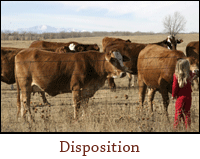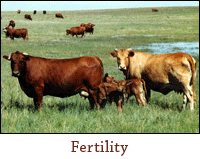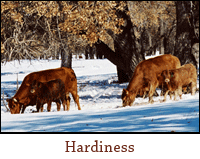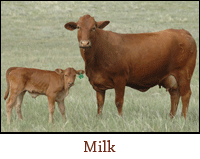An Interesting Genetic Experiment
By: Dale Lasater
The Foundation Beefmaster herd has been a closed herd since 1937, for more than 75 years. That means that no bulls, cows, frozen semen or embryos-no outside genetic material- have been introduced into the herd since that time. As far as we know, this herd, the foundation herd of the Beefmaster breed, is the oldest closed herd of beef cattle in existence.
Tom Lasater (1911-2001), founder of the breed, began asking animal scientists in the late 1950's, when the herd had been closed for more than 20 years, how long a herd this size (450-500 mother cows) could continue as a closed herd. The typical response was: "We don't know, because no one has ever maintained a closed herd of this size for an extended period of time. However, we think that sooner rather than later the herd will develop some type of genetic problem which you will not be able to deal with internally, and that will force you to go outside the herd to bring in new genetics."
For this reason, the herd represents an interesting genetic experiment, as we don't know how long it will be able to continue. Today (2013) we have no indication of any problem, such as that predicted more than 50 years ago, which would force the owners to go outside the herd and bring in other genetics.
The herd also represents an on-going example of the results that can be achieved by a continuous selection program over an extended period of years. In the case of Lasater Beefmasters, it is a herd where selection has been focused on productivity (heifers must conceive at 14-15 months of age, and all females must bring an acceptable calf to the weaning pen each year in order to remain in the herd) and on natural selection (all breeding is done in multiple sire herds; no insecticides of any kind have been used since the late 1960's).
The Foundation Beefmaster herd, originally developed in Falfurrias, Texas, has been located in Matheson, Colorado since the early 1950's. Dale Lasater, a son of Tom Lasater, has been Managing Partner of the ranch since 1986.
Disposition
Having been raised under identical range conditions, the difference in disposition between individuals is apparent during the first several days following weaning. Those with poor dispositions are culled. Thereafter, disposition is judged continually and animals which exhibit unacceptable behavior are culled from the herd.
Fertility
Bulls retained for use in our herd go into service at approximately 14 months of age. All breeding occurs in large multiple-sire herds. For more than 50 years, the bulls with the highest libido and the strongest competitive instincts have left the most progeny. Less fertile bulls, or those less willing to compete, have left little or no progeny.
Females are first exposed at 12 to 14 months of age. All age groups are bred under range conditions during a 45-day breeding season. Here in the Foundation Herd, strict culling on fertility goes back to 1948. That year, Tom Lasater decided that, to remain in the herd, a female would need to calve as a two-year-old, and every successive year, and actually bring an acceptable calf to the weaning pen each year. Those basic production rules have been enforced, with no exceptions, for more than fifty years.
Even cows losing calves for reasons beyond their control, such as having a calf killed by lightning or in a blizzard, are removed from the herd. That ensures that every calf's dam has worked and rested on the same schedule, making all performance data and comparisons more valid.
This selection history means that every bull purchased out of this herd not only carries the visible facts of performance such as weaning weight, yearling weight, and conformation; he also carries the genetic imprint of his dam and other female ancestors who have been held to these stringent production requirements for these many years.
Remember, the goal of a selection program is not to keep every cow in the herd, or, in the case of fertility, to get every cow bred. Herd improvement comes through culling, by weeding out those that don't measure up to their mates. If you are getting plenty of your heifers and cows bred, then tighten the screws: reduce your feeding program and shorten your breeding season. Your herd will advance genetically, and the cattle that make the grade will be producing "more beef for less money."
Weight
Bulls to be retained as herd sires are selected based upon weaning weight, post-weaning gain and yearling weight. Weaning weight primarily measures the milking ability of a bull's dam, but also gives an indication of a bull's own growth potential. Post weaning gain to a year of age (in our program) measures how efficiently a bull is able to convert native forage to pounds of beef. Yearling weight is a combination of weaning weight and post weaning gain and therefore is the most important weight used in selection.
Approximately 85% of the heifer crop is retained for replacements. Only defective heifers or those that appear unable to reach puberty at 14 months of age are culled at weaning. After that time a cow is not culled based on her own weight, but for weaning a lightweight calf. What do we do with all the females resulting from keeping so many heifers? The strict selection for the Six Essentials and the resulting rapid attrition drastically limit internal herd growth.
Conformation
Conformation is defined as "type on the hook, not type on the hoof." Muscling, along with length and width of hindquarters is emphasized in the selection of bulls as potential herd sires. Animals with any type of structural defects such as problems with their feet and legs or frame are culled from the herd.
Hardiness
Hardiness is exemplified by those animals that relentlessly carry on their production assignments year after year in a range environment with minimum assistance. For example in our herd, first-calf heifers are expected to calve out on the range with no assistance. These criteria favor those individuals that are able to carry on production with minimal intervention and with the least cost.
Milk Production
Only bull calves with above average weaning weights are considered as potential herd sires. These bulls will most likely sire daughters that will perpetuate the heavy milking characteristics demonstrated by their individual dams. Lightweight calves, both bulls and heifers, are culled at weaning. Dams weaning bottom-end calves are also culled from the herd.






